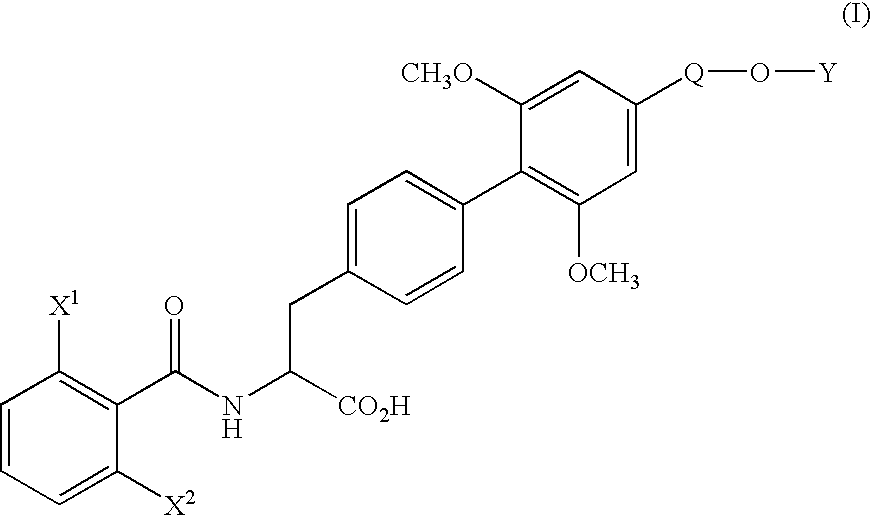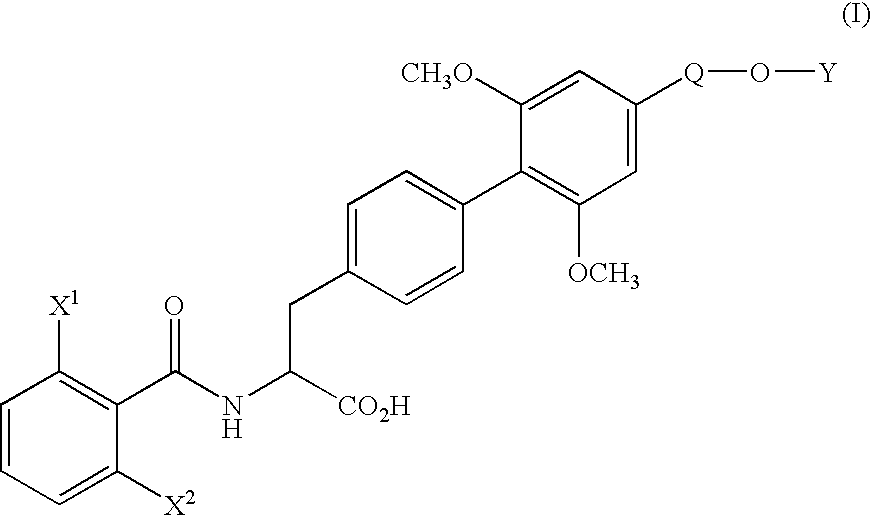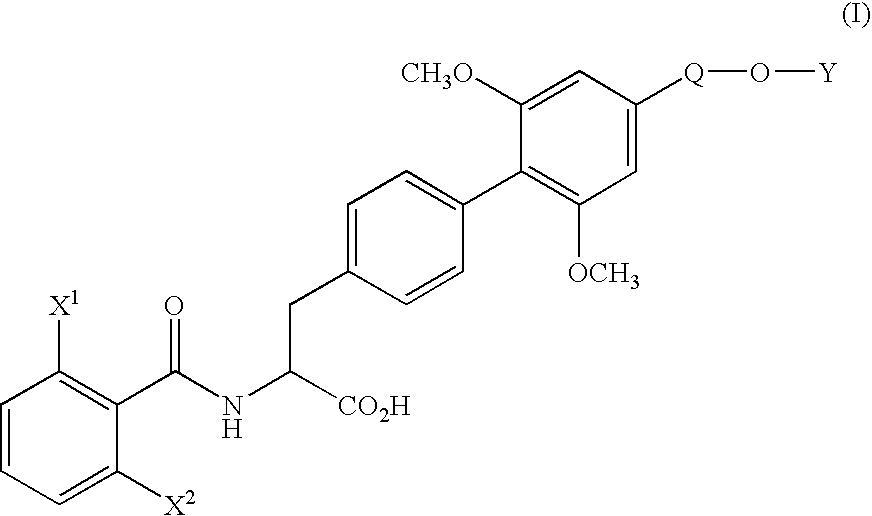Process for preparing a phenylalanine derivative and intermediates thereof
a technology of phenylalanine and derivative, applied in the field of process for preparing a phenylalanine derivative and intermediates thereof, can solve the problem of not being disclosed
- Summary
- Abstract
- Description
- Claims
- Application Information
AI Technical Summary
Benefits of technology
Problems solved by technology
Method used
Image
Examples
example 1
[0071] (1) Under nitrogen atmosphere, pyridine(130.3 g) and trifluoromethanesulfonic anhydride (170.4 g) were added dropwise to a solution of ethyl (αS)-α-[[(1,1-dimethylethoxy)carbonyl]amino]-4-hydroxybenzenepropionate (170.0 g) in dichloromethane (1.7 L) at 10° C. or below. After stirring for 1 hour at the same temperature, water (850 ml) was added dropwise to the mixture and the mixture was stirred for 2 hours at the same temperature. The organic layer was washed with 10% aqueous citric acid solution and aqueous saturated sodium hydrogen carbonate solution, and dried over magnesium sulfate. The solvent was removed in vacuo to yield ethyl (αS)-α-[[(1,1-dimethylethoxy)carbonyl]amino]-4-(trifluoromethanesulfonyloxy)benzenepropionate (242.5 g) as oil.
[0072] MS (m / z): 441 (M+)
[0073] (2) Under nitrogen atmosphere, to a mixture of ethyl (αS)-α-[[(1,1-dimethylethoxy)carbonyl]amino]-4-(trifluoromethanesulfonyloxy)benzenepropionate (66.2 g), 4-ethoxymethyl-2,6-dimethoxyphenylboric acid (...
example 2
[0079] (1) Under nitrogen atmosphere, a mixture of ethyl (αS)-α-[[(1,1-dimethylethoxy)carbonyl]amino]-4-bromobenzene propanoate (11.17 g), 4-ethoxymethyl-2,6-dimethoxyphenylboronic acid (10.80 g), palladium acetate (0.34 g), triphenylphosphine (1.57 g), anhydrous potassium carbonate (12.44 g), N-methylpyrrolidone (56 ml) and water (11 ml) was stirred for 50 minutes at 80° C. After completion of the reaction, the mixture was cooled to room temperature and extracted with ethyl acetate and water. The organic layer was washed with 10% aqueous citric acid solution and saturated aqueous NaCl solution, dried over magnesium sulfate and filtrated. The filtrate was concentrated under reduced pressure to yield ethyl (αS)-α-[[(1,1-dimethylethoxy)carbonyl]amino]-4′-ethoxymethyl-2′,6′-dimethoxy(1,1′-biphenyl)-4-propionate (20.4 g) as oil.
[0080] The product was dissolved in ethanol (100 ml), and after addition of p-toluenesulfonic acid monohydrate (5.7 g), the mixture was stirred for 1.5 hours at...
example 3
[0082] To a solution of ethyl (αS)-α-[(2,6-difluorobenzoyl)amino]-4′-ethoxymethyl-2′,6′-dimethoxy(1,1′-biphenyl)-4-propionate (500 mg) in water (12.6 ml) and dioxane (50 ml) was added hydrochloric acid (12.4 g) and the mixture was stirred for 60 hours at 60° C. The organic solvent was removed in vacuo and the aqueous layer was cooled. The crystalline precipitates were collected by filtration and recrystallized from ethanol-water to yield (αS)-α-[(2,6-difluorobenzoyl)amino]-4′-ethoxymethyl-2′,6′-dimethoxy(1,1′-biphenyl)-4-propionic acid (426 mg). The physicochemical data were the same as that obtained in Example 1.
PUM
| Property | Measurement | Unit |
|---|---|---|
| temperature | aaaaa | aaaaa |
| temperature | aaaaa | aaaaa |
| boiling point | aaaaa | aaaaa |
Abstract
Description
Claims
Application Information
 Login to View More
Login to View More - R&D
- Intellectual Property
- Life Sciences
- Materials
- Tech Scout
- Unparalleled Data Quality
- Higher Quality Content
- 60% Fewer Hallucinations
Browse by: Latest US Patents, China's latest patents, Technical Efficacy Thesaurus, Application Domain, Technology Topic, Popular Technical Reports.
© 2025 PatSnap. All rights reserved.Legal|Privacy policy|Modern Slavery Act Transparency Statement|Sitemap|About US| Contact US: help@patsnap.com



